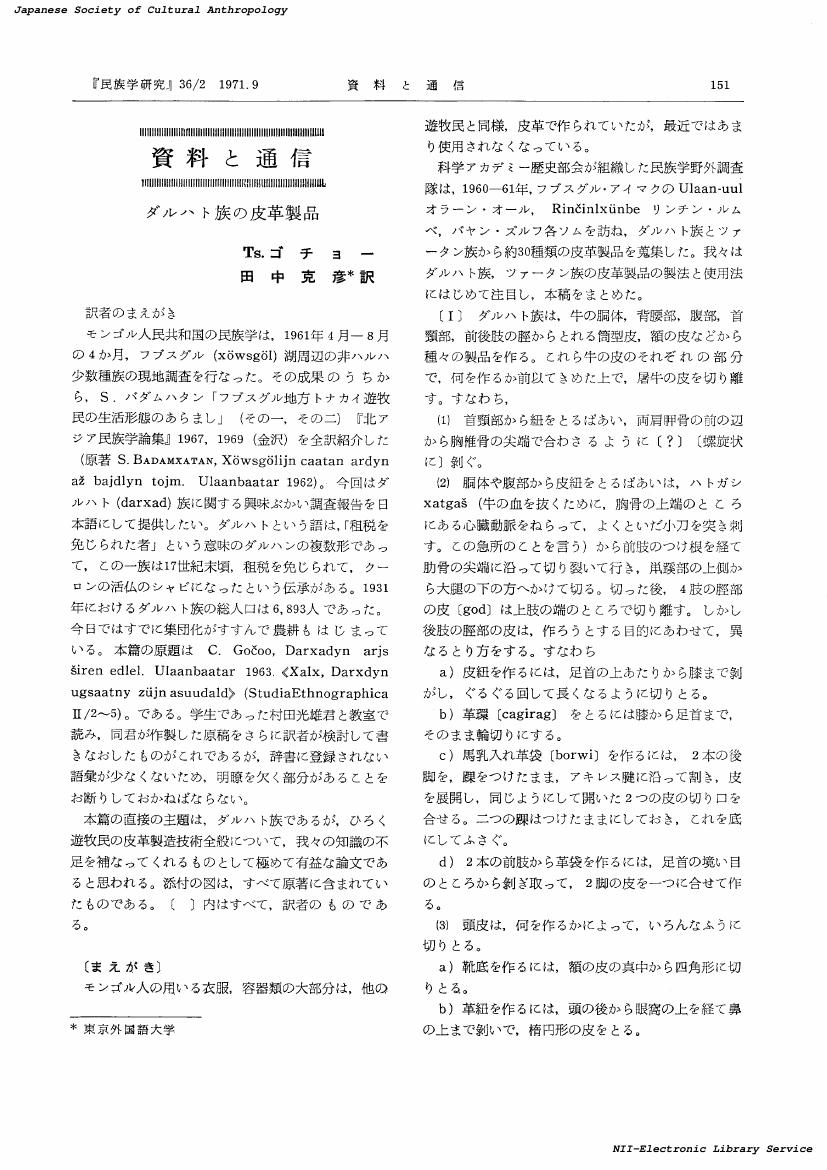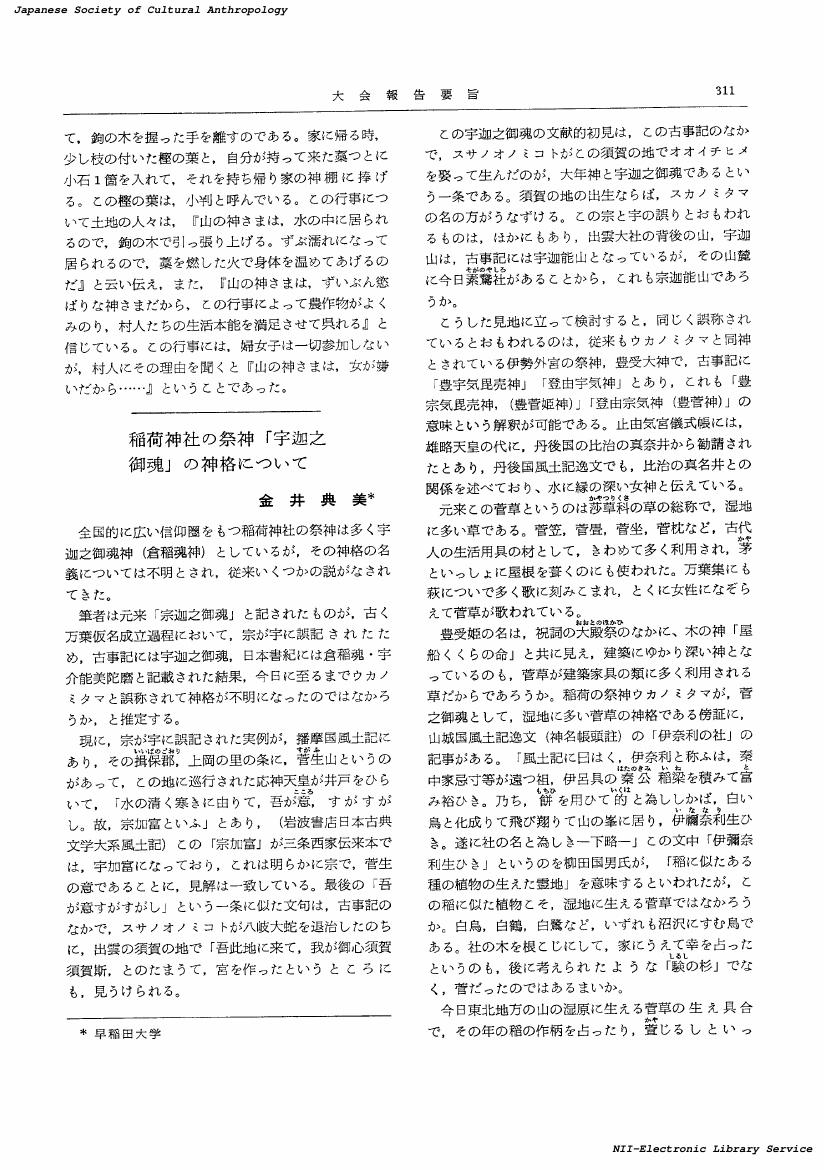- 著者
- 中川 敏
- 出版者
- 日本文化人類学会
- 雑誌
- 民族學研究 (ISSN:24240508)
- 巻号頁・発行日
- vol.64, no.1, pp.123-126, 1999-06-30 (Released:2018-03-27)
1 0 0 0 OA ダルハト族の皮革製品
- 著者
- ゴチョー Ts. 田中 克彦
- 出版者
- 日本文化人類学会
- 雑誌
- 民族學研究 (ISSN:24240508)
- 巻号頁・発行日
- vol.36, no.2, pp.151-157, 1971-09-30 (Released:2018-03-27)
- 著者
- 竹沢 泰子
- 出版者
- 日本文化人類学会
- 雑誌
- 民族學研究 (ISSN:24240508)
- 巻号頁・発行日
- vol.63, no.4, pp.430-450, 1999-03-30 (Released:2018-03-27)
1 0 0 0 OA 日本昔話の型
- 著者
- 関 敬吾
- 出版者
- 日本文化人類学会
- 雑誌
- 民族學研究 (ISSN:24240508)
- 巻号頁・発行日
- vol.21, no.1-2, pp.80-88, 1957-05-30 (Released:2018-03-27)
1 0 0 0 OA 稲荷神社の祭神「宇迦之御魂」の神格について(日本民族学会第 11 回研究大会報告要旨)
- 著者
- 金井 典美
- 出版者
- 日本文化人類学会
- 雑誌
- 民族學研究 (ISSN:24240508)
- 巻号頁・発行日
- vol.37, no.4, pp.311-312, 1973-03-31 (Released:2018-03-27)
1 0 0 0 OA 日琉語族論
- 著者
- 折口 信夫
- 出版者
- 日本文化人類学会
- 雑誌
- 民族學研究 (ISSN:24240508)
- 巻号頁・発行日
- vol.15, no.2, pp.194-206, 1950-11-15 (Released:2018-03-27)
Among the world languages, that which is most akin to Japanese is Ryukyuan, both of which may be classified together as the Ryukyu-Japanese language group. The author seeks for the original common form of this group by comparing the order of word components found in archaic Japanese and Ryukyuan. The problem of the order of word-components suggests also a possibility of special relationships between South China, the South Sea Islands, Formosa, Ryukyu and Japan. The present paper will serve as a preliminary contribution to such a problem. Among Japanese words which have become classic or obsolete since the mediaeval age, there are many which have a reverse order of components as compared with ordinary modern Japanese, such as kataoka, shita kutsu, hashi-date, mo-gari, which means respectively "land beside (kata) a hill (oka), " "a piece of cloth attached under (shita) a bamboo blind (sudare), " "socks worn under (shita) shoes (kuisu), " "an upright (date<tate) ladder (hashi), " "a provisional (gari<kari) funeral hall (mo)." Among the place and personal names, we find evidence that a female was called "Hime so and so" and a male "Hiko so and so" instead of "so and fo Hime" and "so and so Hiko." From the Ryukyuan vocabulary, examples are given mainly concerning personal names, which were intimately connected with the religious life of the islands, and its focus on the female shaman. On the grounds of various religious phenomena as well as relation between posthumous and infantile names of kings and nobles, the author demonstrates that there are many words meaning "one beloved by gods" and that these, too, were originally used in the order reverse to that of present usage. His study on such honorific suffixes as kimi and anji, and such eulogistic words as kikoe and shirare, gives additional examples of reverse word-order. Analysis of words like nozaki (first-fruits), katami (keepsake) etc. shows the archaic customary and ideological background of such words, and possibilities for reconstruction of early Japanese culture are indicated. The author asserts that the two peoples whose languages constitute the Ryukyu-Japanese group have lived in an intimate ethnic relationship for a long time.
1 0 0 0 OA 神功皇后伝承定着の周辺 : 北九州を中心として
- 著者
- 喜多 路
- 出版者
- 日本文化人類学会
- 雑誌
- 民族學研究 (ISSN:24240508)
- 巻号頁・発行日
- vol.36, no.1, pp.22-46, 1971-06-30 (Released:2018-03-27)
- 著者
- 佐々木 高明
- 出版者
- 日本文化人類学会
- 雑誌
- 民族學研究 (ISSN:24240508)
- 巻号頁・発行日
- vol.30, no.1, pp.15-37, 1965-06-30 (Released:2018-03-27)
1 0 0 0 OA ネネツ族の社会 : トナカイ飼養の発展とその影響
- 著者
- 佐々木 史郎
- 出版者
- 日本文化人類学会
- 雑誌
- 民族學研究 (ISSN:24240508)
- 巻号頁・発行日
- vol.49, no.3, pp.203-232, 1984-12-30 (Released:2018-03-27)
1 0 0 0 OA 琉球八重山の伝統的家屋 : その方位と平面形式にかんする覚書
- 著者
- 笠原 政治
- 出版者
- 日本文化人類学会
- 雑誌
- 民族學研究 (ISSN:24240508)
- 巻号頁・発行日
- vol.39, no.2, pp.176-190, 1974-09-30 (Released:2018-03-27)
- 著者
- 倉田 勇
- 出版者
- 日本文化人類学会
- 雑誌
- 民族學研究 (ISSN:24240508)
- 巻号頁・発行日
- vol.33, no.1, pp.62-63, 1968-06-30 (Released:2018-03-27)
1 0 0 0 OA 海のエスノヒストリー : スールー諸島における歴史とエスニシティ
- 著者
- 床呂 郁哉
- 出版者
- 日本文化人類学会
- 雑誌
- 民族學研究 (ISSN:24240508)
- 巻号頁・発行日
- vol.57, no.1, pp.1-20, 1992-06-30 (Released:2018-03-27)
本稿はフィリピンのスールー諸島における海洋民社会についての歴史人類学的研究を目的としている。特に, この地域における歴史とエスニシティの動態を, 西欧側と現地側双方の多様な歴史表象や歴史の語りを通じて明らかにしてゆく。従来の民族誌において, スールー諸島の海洋民社会は, タウスグ族を頂点としバジャウ族を底辺とする民族間階層を成すものとして描かれてきた。本稿では, このようなエスニシティの編成が18世紀後半以降のスールー王国の王権の展開を通じて形成されてきたことを明らかにする。また次に, こうしたマクロな歴史過程は, 現地住民の多様な歴史の語りの中で表象されることを通じて, それを語る民族集団の意識やイデオロギーに応じて解釈され, 再定義されてゆく。こうしてエスニシティが歴史的に形成され, 歴史がそのエスニシティによって再編されてゆくという動態的過程がスールー社会において認められるのである。
1 0 0 0 OA 苗代田(第 2 回研究大会)(第 1, 2 回民協研究大会報告要旨)
- 著者
- 千葉 徳爾
- 出版者
- 日本文化人類学会
- 雑誌
- 民族學研究 (ISSN:24240508)
- 巻号頁・発行日
- vol.29, no.2, pp.141-144, 1964-10-31 (Released:2018-03-27)
1 0 0 0 OA 韓国一巫女の宗教的世界 : 全羅南道珍島の調査から
- 著者
- 網野 房子
- 出版者
- 日本文化人類学会
- 雑誌
- 民族學研究 (ISSN:24240508)
- 巻号頁・発行日
- vol.62, no.3, pp.273-293, 1997-12-30 (Released:2018-03-27)
本稿の主要な目的は, 従来の韓国巫俗研究では, 世襲巫, 司祭という概念により考察されてきたタンゴルという宗教的職能者について, 憑依の側面以外の諸特徴に着目して, その宗教的世界を多面的に描くことである。これは, 憑依の有無を基準として事象を把えようとするシャーマニズム, シャーマン研究の分野からは注目されてこなかった側面だが, タンゴルの属性やその宗教的世界についてのより深い理解は, 世襲/降神という指標のみによっては得られないと思われる。ここでは「タンゴルの側から視る」という立場から主としてタンゴルの巫業活動に注目する。その結果, 第1に明らかなことは, タンゴルは儀礼的に人の生と死に関わる人であり, タンゴルの側からタンゴル自身が人の死と生に関わることの意味を問うた場合, タンゴルにとって死とは必ずしも不浄視されるものではなかった点が重要である。第2に, 死の儀礼を巫女は神と人を仲介すること, 神を喜ばせることと捉えており, 憑依の代わりに音楽が, 神と人を結ぶ技術として用いられており, タンゴルはきわめてすぐれた芸能をもつ集団でもあることが明らかとなる。
1 0 0 0 OA 比較の不幸(<特集>人類学の方法としての比較の再検討)
- 著者
- 杉本 良男
- 出版者
- 日本文化人類学会
- 雑誌
- 民族學研究 (ISSN:24240508)
- 巻号頁・発行日
- vol.68, no.2, pp.242-261, 2003-09-30 (Released:2018-03-22)
人類学において「比較」の方法は時代おくれのものとみなされ、また現地調査そのものも批判の対象になっている。そのような批判に過剰反応して、人類学の一部は、調査、民族誌記述比較など、従来の学問の中心的な営みとされてきた部分をそぎおとし、自己・主体に閉塞する私小説的な相貌を帯びてきている。ラドクリフ=ブラウンやマードックらによる科学主義的な比較研究は、みずからか神の視点に立つ普遍主義的前提にもとづいていたが、レヴィ=ストロース、デュモンらによる遠隔の比較には、西欧中心主義を相対化する視点が含まれていた。デュモンのいう宿命としての比較に対して、非西欧世界の人類学者にはさらに、比較の前提となる単一性、普遍性が外から与えられてきたという点で、大きく異なっている。人類の普遍性、人間の単一性とはキリスト教世界が浸透させてきた神話の意味があるが、このような普遍神話、単一神話は、非西欧世界のエリートによって受容され、定着させられてきた歴史もある。このような限界を意識した、いわば物象化された普遍性を前提とした比較の試みは、西欧中心主義を批判するとともに、人類学のあたらしい可能性をも示唆している。
1 0 0 0 OA <特集>人類学の方法としての比較の再検討 : 序にかえて
- 著者
- 出口 顯
- 出版者
- 日本文化人類学会
- 雑誌
- 民族學研究 (ISSN:24240508)
- 巻号頁・発行日
- vol.68, no.2, pp.214-225, 2003-09-30 (Released:2018-03-22)
- 著者
- 小松 和彦
- 出版者
- 日本文化人類学会
- 雑誌
- 民族學研究 (ISSN:24240508)
- 巻号頁・発行日
- vol.68, no.2, pp.301-305, 2003-09-30 (Released:2018-03-22)
1 0 0 0 OA 陰陽五行による日本民俗の構造的把握
- 著者
- 吉野 裕子
- 出版者
- 日本文化人類学会
- 雑誌
- 民族學研究 (ISSN:24240508)
- 巻号頁・発行日
- vol.45, no.2, pp.134-159, 1980-09-30 (Released:2018-03-27)
In the serialized reports the writer gave in this journal's previous issues entitled "Studies on Ise Shrine, Part I-III, the contention is that what we conceive of as typically Japanese festivities observed and conducted in the Shrine were actually very much influenced by the old Chinese philosophical thinking of "Cosmic Dual Forces and Five Natural Elements' as envisioned in the enshrining of AMATERASU, the Imperial ancestral goddess in the Ise Shrine. She was the incarnation of the Chinese cosmic god of Tai-Yi, the mythical identification of the North Star and to the Geku goddess, the outer Shrine, the enshrining of the Big Dipper. While festivals observed at Ise Shrine are Imperial Household rituals, the thought of Cosmic Dual Forces and Five Natural Elements was also widely and forcefully applied and practiced in the public domain such as in the festivities, seasonal change customs and in conjurations to avoid ill omens and calamities. The present report is a study of such phenomena. According to ancient Chinese philosphy. CHAOS was the one and only absolute being in the primordial age. Out of this CHAOS, the light, clear and clean Yang (陽) atmosphere rose to form the Heavens while the dark, heavy and murky Yin (陰) atmosphere descended to form the land. Since the two poles of Yin (陰) and Yang (陽) are the spinoff from the same maternal substance, the CHAOS, their roots are identical and therefore, they would attract one another, mingle and react, and as a result, would produce the five natural elements of Wood, Fire, Earth, Metal and Water. Every phenomenon was categorized into one of these five natural elements. The colours, directions, seasons, times, virtues, sounds and the kinds of living creatures to such natural phenomena as thunder, wind and so forth were all conformed into one of these five natural elements. To illustrate, the wood spirit symbolizes the Spring of the seasons, blue is its colour, East is its direction, and Morning in time, while the Fire spirit symbolizes Summer, Red, South and Noon, and Metal, Autumn, White, West and Evening respectively. There was another thought regarding these five Natural Elements which was reactionary in its function:one was continuity and amity, while the other was conflict and struggle. Continuity and amity will bear Fire from the Wood while Fire will bear Earth and the Earth, the Metal and the Metal bears Water while Water bears Wood. This is the plus or positive factor relation. The conflict and struggle are negative or minus relation in which the Wood overcomes Earth, and Earth the Water and Water the Fire and Fire the Metal, with Metal overcoming the Wood. These two opposing and reactionary functions serve to guarantee the perpetuation of all living matter. What the Chinese emphasized most was the smooth transition of the four seasons. They believed that people should actively participate and assist the natural transition of seasons and to this end the ancient Chinese emperors wore blue clothes and blue jewels to meet the Wood spirit on the first day of Spring (calendar date) and walked out to the East suburb to personally welcome the Spring. By the same token. in summer they wore red clothes and red jewels and walked out to the South suburb. Thus, by personally greeting the four seasons, they encouraged the natural transition of the seasons. For the Japanese, a race dependent on rice crops, they too would seek a regulated transition of the four seasons and the principle practiced in China would be utilized and practiced.
1 0 0 0 OA 長崎華僑における祭祀と芸能 : その類型及びエスニシティの再編
- 著者
- 王 維
- 出版者
- 日本文化人類学会
- 雑誌
- 民族學研究 (ISSN:24240508)
- 巻号頁・発行日
- vol.63, no.2, pp.209-231, 1998-09-30 (Released:2018-03-27)
本稿では, 長崎華僑社会を一つのエスニック・グループとしてとらえ, 祭祀や芸能に焦点を当てることにより, 華僑文化のダイナミズムを再検討した。祭祀と芸能は, 変動するエスニシティにとって重要な意味をもつ文化要素である。日本華僑の場合, 住居, 服装, 生活様式など文化の日常的側面においては, 日本社会への同化の傾向が強い。その代わりに弁別的特徴として重要な役割を果たしてきたのが祭祀と芸能である。祭祀については次の3タイプに類型化することができる。1)「被受容祭祀」 : 江戸時代に日本人社会に受容され日本の祭と混淆して現在に受け継がれているもので, 「長崎くんち」に代表される。2)「伝統祭祀」 : 同郷組織等によって運営され, 華僑の寺院で行われる「普度勝会」(盂蘭盆)などの祭祀。3)「新伝統祭祀」 : 中華街の活性化を目的として, 近年に春節(旧正月)・元宵節等を再編して創造された新たな祭。旧来のエスニック・アイデンティティのシンボルとしての「伝統祭祀」は同郷組織によって維持されてきた。しかし, 第二世代は伝統祭祀への関心を失いつつあり, 長崎華僑社会は近年急速に変化を示している。それは, 特に「新伝統祭祀」ランタンフェスティバルの創設過程にみることができる。ランタンフェスティバルは, 政治的変化(日中国交正常化)を契機とし, 観光と地域活性化という新たなニーズによって, 新たなエスニック・アイデンティティのシンボルとして中華街を中心に創造されたものである。それに先だって, 中華街の二代目店主らは, 日本人店主らとともに, 新しい組織として中華街商店街振興組合を結成した。こうして, 長崎華僑のエスニック・アイデンティティは, 同郷組織を核とし「伝統祭祀」をシンボルとするものと, 振興組合を核とし「新伝統祭祀」をシンボルとするものとに二極化してきた。さらに, 長崎市は, 中華街で創設された「新伝統祭祀」を市全体の祭として取り込んだ。長崎は, 古くから華僑の文化を「被受容祭祀」として取り入れることにより, 自らの地域文化を構築してきたが, そうした過程が現代的な形で再生産されているととらえることも可能である。このように, エスニック・グループとしての長崎華僑社会は, 上位社会(日本社会及び長崎地域社会)や出身社会(本国)との交渉の中でエスニシティ再構成をしているのみならず, 上位社会に対しても影響を与え続けていると言えよう。
1 0 0 0 OA まりも祭りの創造 : アイヌの帰属性と民族的共生
- 著者
- 煎本 孝
- 出版者
- 日本文化人類学会
- 雑誌
- 民族學研究 (ISSN:24240508)
- 巻号頁・発行日
- vol.66, no.3, pp.320-343, 2001-12-30 (Released:2018-03-27)
北海道阿寒湖畔において50年間続けられてきたまりも祭りは、アイヌの伝統的送り儀礼の形式を取り入れて創られた新しい祭りである。当初、この創られた伝統は、アイヌ本来の祭りではない、あるいはアイヌ文化を観光に利用しているという批判を受けることになった。しかし、祭りを主催するアイヌの人々は、この祭りは大自然への感謝祭であると語る。本稿では、まりも祭りの創造と変化の過程、それをめぐる語り、阿寒アイヌコタンと観光経済の関係、さらに現在行われているまりも祭りの分析から、アイヌの帰属性と民族的共生の過程を明らかにする。その結果、(1)アイヌの民族性の最も深い部分にある精神性の演出により、新しいアイヌ文化の創造が行われていること、(2)この祭りの創造と実行を通して民族的な共生関係が形成され、それが維持されていること、(3)そこでは、アイヌとしての民族的帰属性が、アイヌと和人とを含むより広い集団への帰属性に移行していること、が明らかになった。さらに、最後に、民族的共生関係の形成を可能にするのは、経済的理由や語りの技術によるだけではなく、異なる集団を越えて、それらを結び付ける人物の役割と人間性が重要であることを指摘した。












